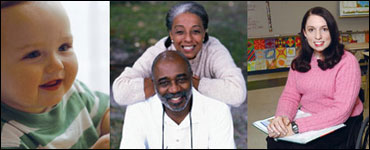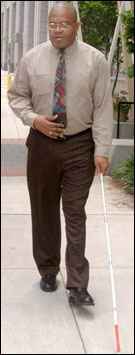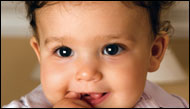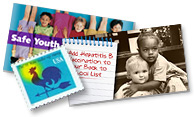CDC Features
Current Features
October is Disability Awareness Month

Today, about 50 million Americans, or one in five people, are living with at least one disability, and most Americans will experience a disability at some time during the course of their lives. Some disabilities are easy to see, such as when a person uses a wheelchair or when someone has lost an arm. Other disabilities, like a developmental disability such as autism or a chronic condition like arthritis, may not be as easy to see. Some people may live with a disability all their lives. Others may have a disability when they are young or as an older adult. Different kinds of disabilities affect people in different ways. And the same disability can affect each person differently.
In recognition of Disability Awareness Month, CDC encourages everyone to learn more about what is being done to identify the causes of developmental disabilities and promoting the health and well-being among people of all ages with disabilities within the National Center on Birth Defects and Developmental Disabilities.
Developmental Disabilities
In recognition of Disability Awareness Month, NCBDDD will host a presentation by Ms. Eustacia Cutler, author of A Thorn in My Pocket and mother of Temple Grandin, who was diagnosed with autism in the 1950s when autism awareness and support systems were not in place. See flyer (![]() PDF) for more information. Registration is required. A panel discussion will follow Ms. Cutler’s presentation featuring members of the community affected by developmental disabilities.
PDF) for more information. Registration is required. A panel discussion will follow Ms. Cutler’s presentation featuring members of the community affected by developmental disabilities.
Developmental disabilities are a diverse group of severe chronic conditions that are due to mental and/or physical impairments. People with developmental disabilities have problems with major life activities such as language, mobility, learning, self-help, and independent living. Developmental disabilities begin anytime during development up to 22 years of age and usually last throughout a person’s lifetime. Developmental disabilities affect approximately 17% of children younger than 18 years of age in the United States.
Developmental disabilities activities at CDC include:• Studying how common developmental disabilities are and who is more likely to have them.
• Finding the causes of developmental disabilities and the factors that increase the chance that a person will have one.
• Learning how people with developmental disabilities can improve the quality of their lives.
Learn more about developmental disabilities, such as autism spectrum disorders, cerebral palsy, intellectual disabilities, hearing loss, and vision impairment.

Disability and Health
Since the Americans with Disabilities Act was passed 17 years ago, we have removed or reduced many social barriers. Buildings are more accessible. Employment opportunities are greater. This has enabled people with disabilities to become more independent and involved in their world. But are they healthier? Often they are not. CDC research shows that people with disabilities generally report poorer health than people without disabilities. Also, people with disabilities often smoke more, are more often obese, and get less exercise than people without disabilities. Their health problems may require different solutions than people without disabilities. How can a man get enough exercise if he uses a wheelchair? Does a woman with a cognitive disability know where to get a flu shot? We can help people with disabilities become healthier by including them in smoking cessation programs, community fitness programs, and health messages.

CDC's Learn the Signs. Act Early. campaign aims to help parents of young
children identify possible developmental delays and encourage them to discuss
concerns with their health care professional.
Disability and health activities at CDC include:
• Studying how many people have disabilities and their health status.
• Researching the risk factors for poor health and well-being of people with disabilities.
• Promoting healthy lifestyles among people with disabilities.
About CDC's National Center on Birth Defects and Developmental Disabilities
CDC's National Center on Birth Defects and Developmental Disabilities (NCBDDD) promotes the health of babies, children, and adults, and enhances the potential for full, productive living.
Our work includes identifying the causes of and preventing birth defects and developmental disabilities, helping children to develop and reach their full potential, and promoting health and well-being among people of all ages with disabilities. Visit the NCBDDD Web site to learn more about our programs and activities.
Send a Disability Awareness eCard.
Additional Information and Resources
- Information on Developmental Disabilities
- Information on Disability and Health
- Disability Disparities
- Minorities with Disabilities
- Families with Special Needs
- The United States Department of Health and Human Services, Office on Disability
- The United States Department of Health and Human Services, Office of the Surgeon General
-
Surgeon General's Call to Action to Improve the Health and Wellness of Persons with Disabilities (
 PDF)
PDF)
Page last updated: October 5, 2007
Content source: National Center for Birth Defects and Developmental Disabilities
Content owner: National Center for Health Marketing
URL for this page: www.cdc.gov/Features/DisabilityAwareness


